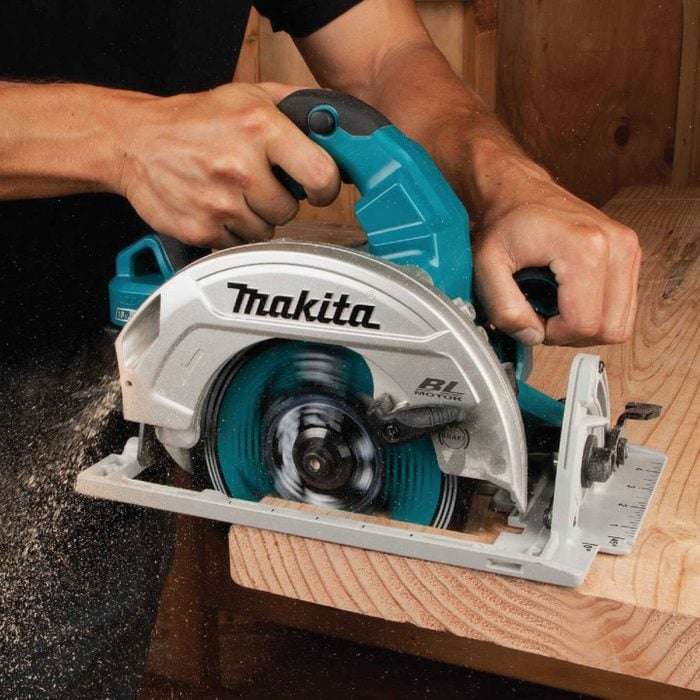
Choosing a Circular Saw
The first power tool — an electric drill — was invented in 1889. Less than 40 years later, the Skilsaw Company produced the first handheld circular saws. These offered obvious advantages over hand sawing. Now, no one who works with wood would be without one.
Today, multiple refinements of this essential tool make it indispensable. Pretty much every circular saw includes features like plastic housings, blade guards and adjustable bases. But designs vary. The saws with the most sophisticated and user-friendly features often cost more … but not always.
Features to consider when buying a circular saw
Although many circular saw features are standard, manufacturers continue to incorporate new ones into more sophisticated designs. Here are some of the standard and not-so-standard features to consider as you shop for the best circular saw for your purposes.
- Gear-driven or direct drive: The worm-drive circular saw was the first one invented. It develops more cutting torque than a sidewinder, i.e. a saw with a blade mounted next to the motor and connected directly to the drive shaft. Worm-drive saws are preferred for heavy construction, though the blade spins more slowly and makes rough cuts. Hypoid saws are a variation of the worm-drive model.
- Bevel capacity: The base or shoe tilts for making bevel cuts, but not all models tilt the same amount. The best circular saw bevels more than 45 degrees with positive stops at 22.5 and 45 degrees, saving time when making adjustments.
- Adjustment controls: Look for easy-to-operate adjustment levers for tilt angle and cutting depth. Turn screws take more time and can slip.
- Tool weight: Heavy saws are more tiring and awkward to use. Housing and base materials influence weight. The best circular saw has a magnesium or plastic body and an aluminum or magnesium shoe. Besides their weight, steel shoes can bend and rust.
- Ergonomics: The best circular saw for most uses should be lightweight and compact with easy-to-operate controls. Beware of saws that require you to keep the trigger stop depressed while simultaneously holding the trigger. It’s tiring and limits your freedom of movement.
- Desirable features: The best include positive bevel stops, onboard wrench storage for quick blade changing and an LED guide light. You’ll appreciate the LED when your shadow blocks the room light, making the cut line hard to see. Some saws offer a laser guide, but the usefulness of this feature is debatable.
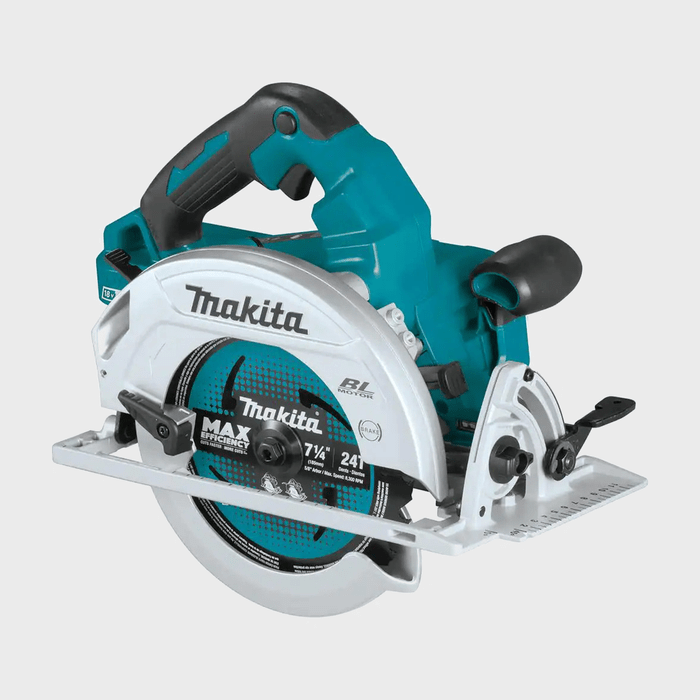 Via Merchant
Via Merchant
Best Circular Saw Overall
The price tag qualifies it as splurge. But if you aren’t on a budget, the Makita 18V X2 LXT Circular Saw delivers corded power in a cordless model. It features a 7-1/4-in. blade, 2-5/8-in. cutting depth and a brushless worm-drive motor that delivers fast blade rotation (6,000 revolutions per minute) to eliminate chip-out problems.
It weighs only 10 pounds with two on-board batteries. It also features variable blade speed, a blade brake, dust blower and a 56-degree bevel with positive stops. Nice.
Product Specs:
- Power Source: Cordless battery
- Speed: 6,000 RPM
- Bevel Capacity: 56 degrees
- Weight: 10.5 pounds
- Blaze Size: 7 ¼ inches
- Blade Location: Right
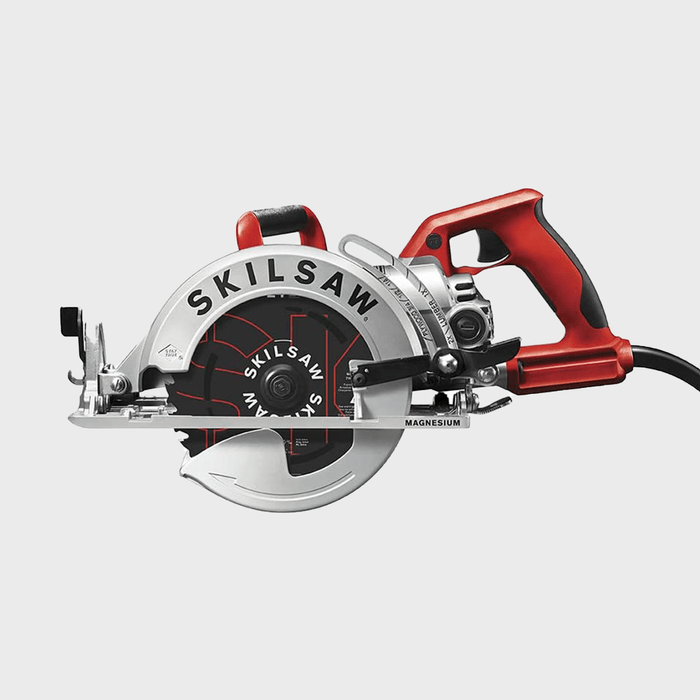 Via Merchant
Via Merchant
Best Worm-Drive Circular Saw
The Skilsaw SPT77WML-01 Lightweight Worm-Drive Circular Saw is modeled after the original Skilsaw invented in 1924, but updated with modern features.
The magnesium body makes it lighter than other worm-drives. The bevel plate tilts 53 degrees, and the anti-snag blade guard keeps the saw on track even when cutting small pieces.
One caution: The saw blade rotates more slowly than those on sidewinder saws. The resulting chip-out can be a problem on rip cuts.
Product Specs:
- Power Source: Corded
- Speed: 5,300 RPM
- Bevel Capacity: 53 degrees
- Weight: 11.5 pounds
- Blaze Size: 7 ¼ inches
- Blade Location: Straight
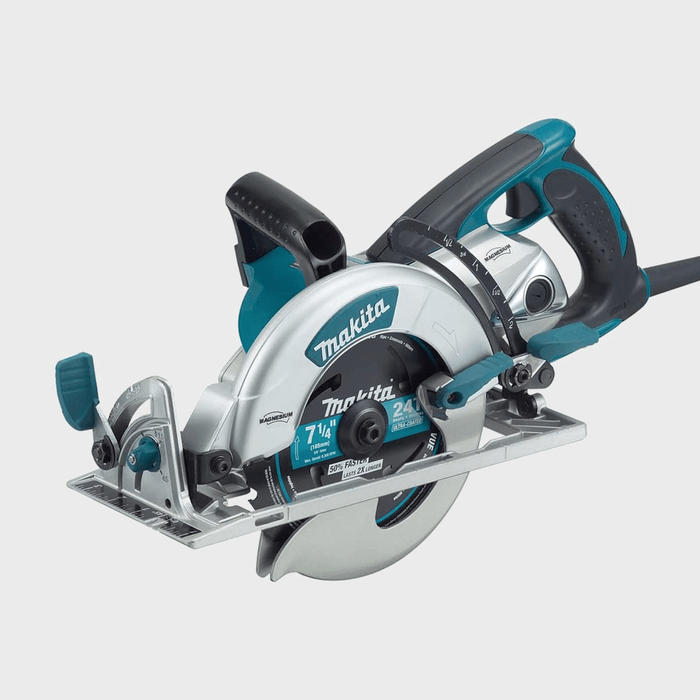 Via Merchant
Via Merchant
Best Hypoid Circular Saw
Makita, a reliable name in power tools, is one of the few manufacturers offering hypoid saws. With its lightweight magnesium construction, the Makita 5377-MG Circular Saw weighs only 13 pounds, light for a geared saw.
The gears are made of heat-treated steel, which wears longer than the bronze-alloy ones of traditional worm-drive saws. It bevels to 51.4 degrees, and there are positive stops at 22.5 and 45 degrees for quick changes. The gear housing is sealed, and the gears, unlike traditional worm-drive gears, never need lubricating.
Product Specs:
- Power Source: Corded
- Speed: 4,500 RPM
- Bevel Capacity: 51.5 degrees
- Weight: 13.2 pounds
- Blaze Size: 7 ¼ inches
- Blade Location: Left
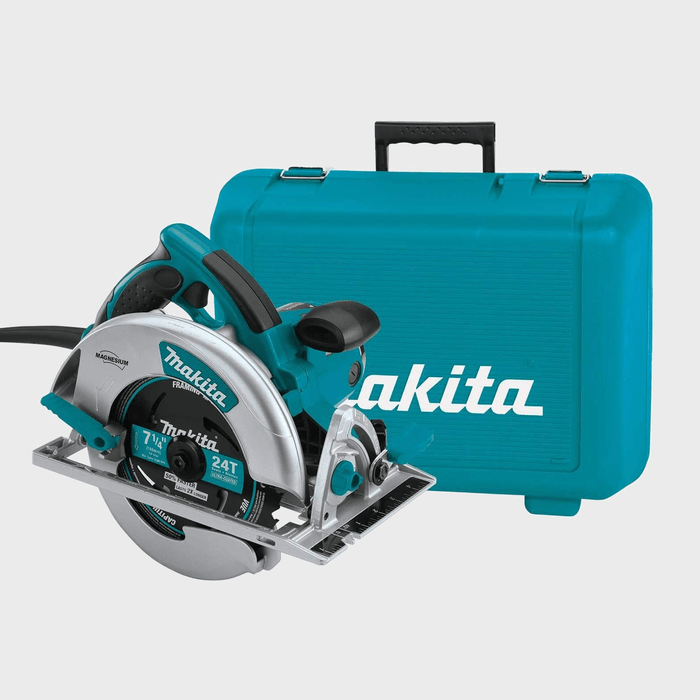 Via Merchant
Via Merchant
Best Corded Sidewinder Circular Saw
Makita again takes top honors with its all-magnesium 5007 Mg 7-1/4-in. Circular Saw. This saw, which comes with a carrying case (a nice touch), weighs in at only 10.6 pounds. It bevels all the way to 56 degrees, with positive stops at 22.5 and 45 degrees.
The ergonomic design features a front handle for extra stability, a built-in dust blower to keep the cut line clear and two LED guide lights. This is the tool you need for your next framing project.
Product Specs:
- Power Source: Corded
- Speed: 5,800 RPM
- Bevel Capacity: 56 degrees
- Weight: 10.1 pounds
- Blaze Size: 7 ¼ inches
- Blade Location: Right
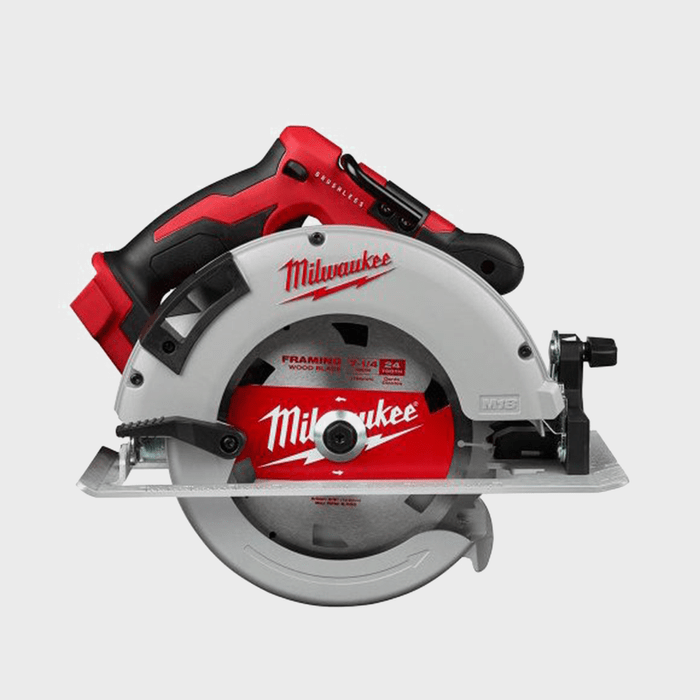 Via Merchant
Via Merchant
Best Cordless Sidewinder Circular Saw
Many cordless sidewinder saws come with undersized blades to make them more compact and save on power. Not the Milwaukee M-18 Brushless Circular Saw, which takes the same 7-1/4-in. blade corded saws use. It’s equally useful in the shop and on a construction site.
The 5-amp hour battery, discreetly placed to keep it out of the sight line, provides enough power to the brushless motor to rip hundreds of feet of plywood. It’s a little heavy but has an extra handle to compensate.
Product Specs:
- Power Source: Cordless battery
- Speed: 5,000 RPM
- Bevel Capacity: 50 degrees
- Weight: 7.2 pounds
- Blaze Size: 7 ¼ inches
- Blade Location: Right
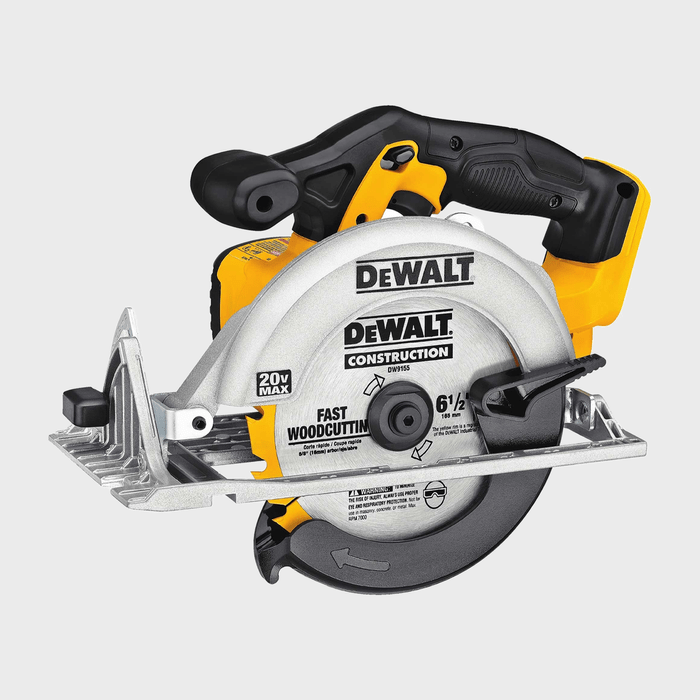 Via Merchant
Via Merchant
Best Starter Woodworking Circular Saw
If you’re just starting out in woodworking, you’ll probably find a cordless saw easier to use than a corded one. The DeWalt 6-1/2-in. 20V Max Circular Saw will get you up to speed in no time.
This is the first saw on the list that costs less than $100. It features a lightweight plastic body and magnesium shoe. The undersized blade makes it easier to handle than a saw with a full-sized blade.
Product Specs:
- Power Source: Cordless battery
- Speed: 5,150 RPM
- Bevel Capacity: 50 degrees
- Weight: 7.1 pounds
- Blaze Size: 6 1/2 inches
- Blade Location: Left
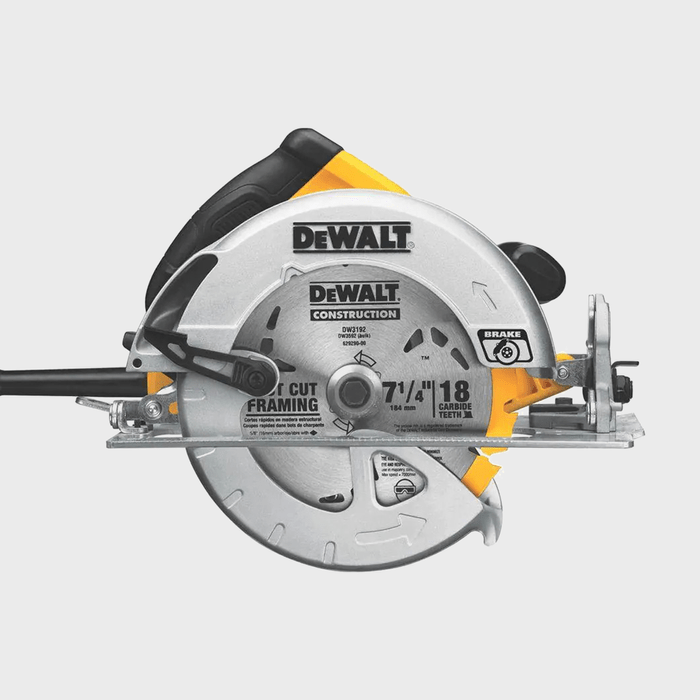 Via Merchant
Via Merchant
Best Pro-Grade Woodworking Circular Saw
If you’re working eight-hour days on the jobsite, you need a lightweight saw that can handle heavy-duty tasks. At only 8.8 pounds, the DeWalt 7-1/4-In. Circular Saw is one of the lightest. The corded 15-amp motor works all day without flagging.
The electric brake eliminates waiting for the blade to stop, and the bevel capacity is 57 degrees — more than most saws. Aluminum shoe, adjustment levers (not turn screws) and on-board wrench storage for quick blade changes make it a trusty companion on the jobsite.
Product Specs:
- Power Source: Corded electric
- Speed: 5,200 RPM
- Bevel Capacity: 57 degrees
- Weight: 8.8 pounds
- Blaze Size: 7 ¼ inches
- Blade Location: Right
 Via Merchant
Via Merchant
Best Cordless Mini Circular Saw
The blade may be only 4-1/2-in., but the 20-volt battery of the DeWalt Atomic Circular Saw provides the same power as a full-sized saw. The barrel handle, typical of mini-saws, provides a steady grip for ripping plywood, slicing through 1-1/2-in. stock and other utility jobs.
This saw comes with a removable auxiliary handle, a dust blower and on-board blade wrench storage. It also features a quick-stop brake.
Product Specs:
- Power Source: Cordless
- Speed: 4,500 RPM
- Bevel Capacity: 45 degrees
- Weight: 5.5 pounds
- Blaze Size: 4 ½ inches
- Blade Location: Left
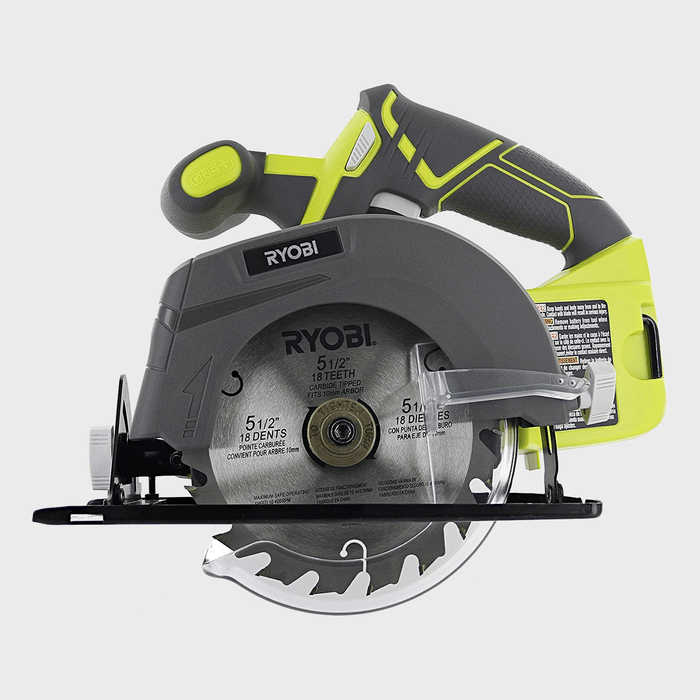 Via Merchant
Via Merchant
Best Budget Circular Saw
Even if you purchase the Ryobi One+ 5-1/2-in. Circular Saw with the battery and charger, it still costs less than most others. But if you already own tools in Ryobi’s One+ system, you can buy just the saw for about $40.
This saw can do most of the same jobs as a more expensive one, as long as you’re not cutting through six-inch beams. It features a 50-degree bevel angle and on-board wrench storage.
Product Specs:
- Power Source: Cordless
- Speed: 4,700 RPM
- Bevel Capacity: 50 degrees
- Weight: 4.8 pounds
- Blaze Size: 5 ½ inches
- Blade Location: Left
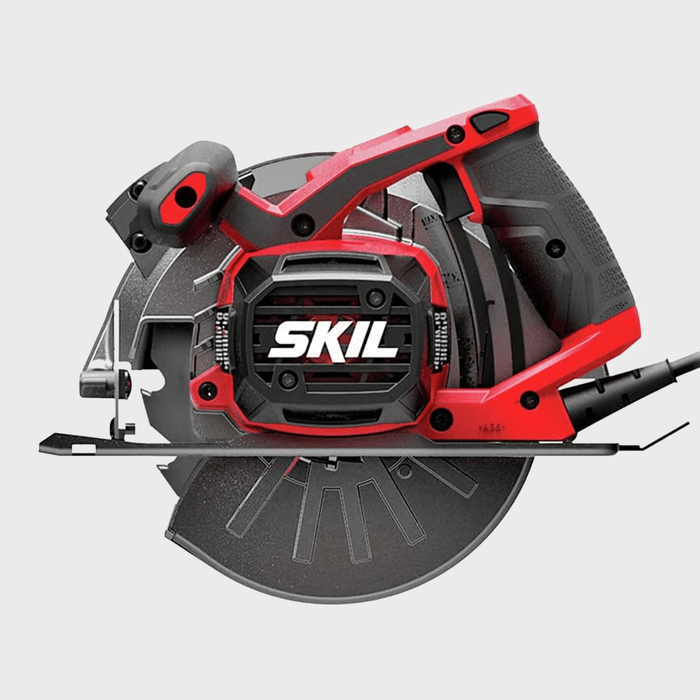 Via Merchant
Via Merchant
Best Value Circular Saw
The Skil 15-Amp 7-1/4-In. Circular Saw is an almost pro-grade model at less than half the cost. Rating 4.7-stars on Amazon, it weighs only 8.7 pounds with a 51-degree bevel angle.
Useful features include the dust blower and the additional handle in the front. Some users may appreciate the guarded trigger and laser guide. Even without them, this tool is a great buy.
Product Specs:
- Power Source: Corded electric
- Speed: 5,300 RPM
- Bevel Capacity: 51 degrees
- Weight: 8.7 pounds
- Blaze Size: 7 ¼ inches
- Blade Location: Right
